ASRock X58 Extreme3: An Enthusiast X58 Motherboard at a Budget Price?
by Ian Cutress on June 2, 2010 4:10 PM EST- Posted in
- Motherboards
- Intel
- ASRock
- X58
ASRock have gone down a pseudo-Gigabyte route in terms of board colour, opting for a blue and white component combination like Gigabyte, but on a black PCB. The main thing you will notice on the board is a fan on the tall FET heatsink next to the CPU, which is connected to the northbridge via a heatpipe. It's not common to see vendors provide a fan for this section of the motherboard, although we suppose ASRock are including it to keep FET and Northbridge temepratures within bounds during overclocked scenarios. The fan itself is barely audible above other GPU and CPU fans, and keeps the area cool in our overclocked scenario, even if the northbridge is warm and despite the heatpipe connecting the two.
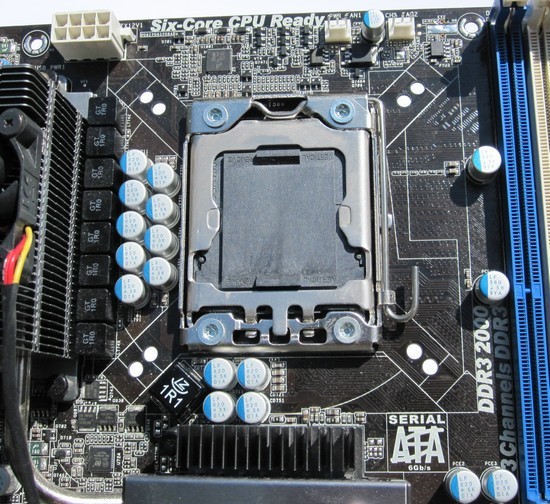
The socket area is relatively similar to other boards in the range - we had no such issues installing an Akasa Nero or a Corsair H50-1. However, the tall FET cooler will limit large coolers, such as the Prolimatech Armageddon, to one orientation only. The 'Combo Cooler Option' (ASRock marketing language for having holes for both 775 and 1366 coolers) is a nice addition to this area of the board, as mentioned previously.
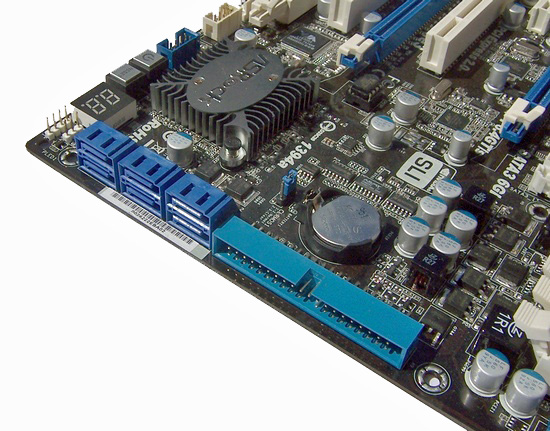
The SATA 3Gb/s ports are found at right angles to the board, so as not to disrupt any long PCIe cards used. Next to it is an IDE connector port, which despite hardware advances, is still in use today, even on enthusiast platforms. The same thing applies to the floppy port - a lot of industrial machinery still outputs data onto the floppy, so a workstation based on an enthusiast motherboard should be able to cope. However, the floppy drive connector is well out of the way, making it hard to reach should you need it. Where it would normally be, i.e. above the IDE port, is the system panel connectors and a USB header. It seems odd to put the system panel up in this area - most cases are designed to place the system panel in the bottom right hand side of the PCB.
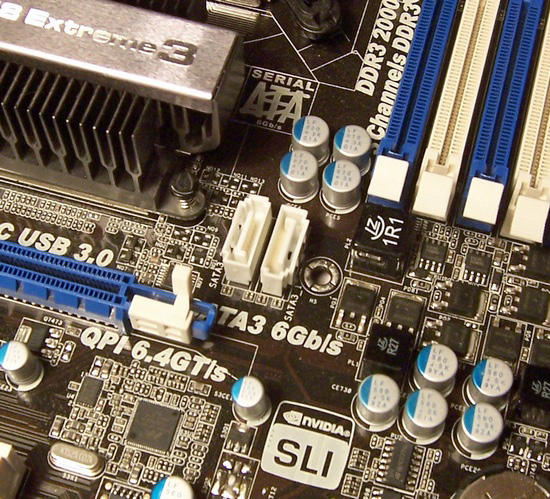
The SATA 6Gb/s ports are straight in the middle of the board. This is relatively absurd. As a result, SATA cables with either be stretching over RAM or graphics cards/power cables to get where they need to go - there is no cable management system in the word which will get around these issues.

Power and Reset buttons are starting to become a standard on boards designed for overclockable platforms, and the Extreme3 does not disappoint. Next to these two is a Debug LED, giving a two character hexadecimal code as the board boots up, and handy when dealing with support on a boot up issue.
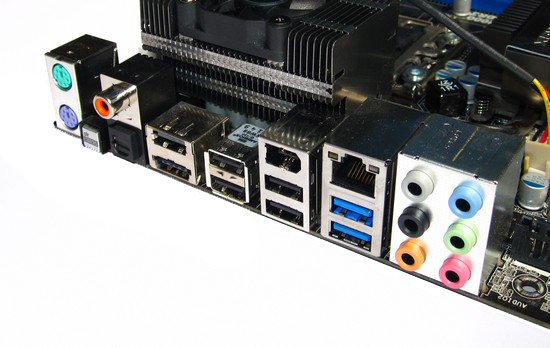
The back panel contains (from left to right) mouse and keyboard PS2 ports, a CLR CMOS button, coaxial and optical SPDIF, connections, a combined eSata 6Gb/s/USB2 port, five other USB2 ports, an IEEE 1394 FireWire port, two USB3 ports, a Realtek Gigabit LAN port, and the usual array of audio ports. While a board on an enthusiast socket may suggest dual LAN ports, given the budget end of the platform this board is aimed at, one LAN port seems fair. Despite the legacy nature of other parts of the board (such as the floppy and IDE connector), no serial or parallel ports are given on the Extreme3.


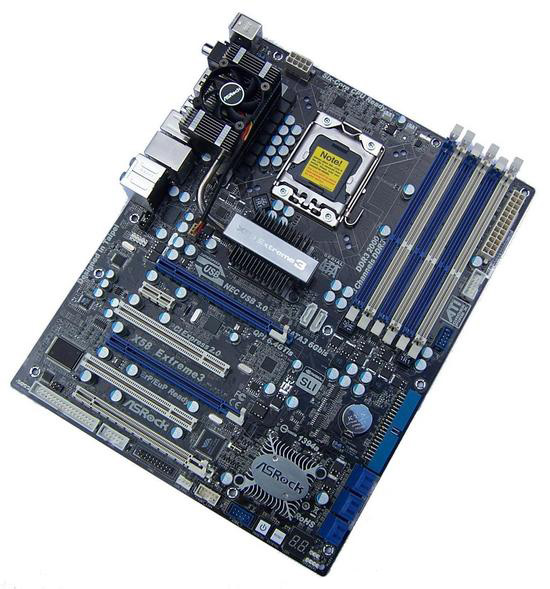








35 Comments
View All Comments
Glenn - Wednesday, June 2, 2010 - link
I believe for $15 more I would go with the Gigabyte X58A-UD3R. I like asrock boards and have had good luck in the past using them, but they need to provide more wow at this pricepoint or be substatially less than the proven enthusiast boards.DigitalFreak - Wednesday, June 2, 2010 - link
Yep, it makes no sense. The comparison should have been with the X58A-UD3R, even if it is a few dollars more.You get 4 PCI-E x16 slots (x16+x16, x16+x8+x8, x8, x8, x8, x8), two PCI-E x1 slots and ONE PCI slot. How many people really need more than 1 PCI slot anymore?
bobvodka - Thursday, June 3, 2010 - link
Well, I do for one.. I'm currently using a Creative X-Fi Elite Pro sound card which is PCI. I'm sticking with it because it has an awesome IO console I can sit on my desk so I can swap quickly to headphones and between headphone sets (one set is better for general usage, but when I need to talk to people I've got a headset I use but the sound repro isn't quite as good). So, while it still works I'll stick with it, heck I don't even know if the later PCIe X-Fi cards can even drive the IO Console...On my current X58 motherboard my other PCIe slots are either;
- being used for graphics
- being used for a PCIe wifi card
- being used for a GTS-260 physx card
- blocked
bobvodka - Thursday, June 3, 2010 - link
oh, I totally misread the comment I was replying to... disregard the above, I thought it said 'requires one PCI slot'; sorry.Araemo - Thursday, June 3, 2010 - link
I have to agree. I have only had one ASRock board... it was so extremely picky, with misleading and undocumented BIOS settings that impacted stability and overclocking greatly, and nonexistant support.That said, for the price, it gave me a (after months of fiddling) 95% stable, high performance system for 2 years for a fraction of the price I'd have paid for another board. But it only lasted about those 2 years before it started showing random crashes, lock ups, disappearing DVD drives, and other odd issues.
Araemo - Thursday, June 3, 2010 - link
Also, since when is a $180 motherboard considered a budget price? Damn. I just built my wife a computer with a (now quad-core) AMD processor of decent performance with a very solid ASUS motherboard.. the motherboard cost $70. I can understand paying $100-$150 for a feature-rich overclocking motherboard, but that isn't what I'd call a 'budget' price at all. :PTaft12 - Thursday, June 3, 2010 - link
Spoken like someone who has never looked at X58 motherboard pricing. Core i7 is for a different market than your wife.Pessimism - Thursday, June 3, 2010 - link
What the original poster is trying to say is that intel should immediately drop the core2, i3, and i5 lines, cut the pricing of the i7 line to sub-$100, cut x58 board pricing to $75 and advance computing as a whole while wiping AMD off the map.Araemo - Saturday, June 5, 2010 - link
I've looked at it - but the performance difference isn't worth the extra $400 you have to spend on an X58 based system Vs. and AMD or Core 2 Duo system.Affectionate-Bed-980 - Sunday, June 6, 2010 - link
Wrong comparison. X58-UDR3 is just outdated. I don't care about price. It's like comparing this year's car against last year's competitor. Okay? But that's not a direct comparison when talking new cars.... sigh.